Helmet Safety
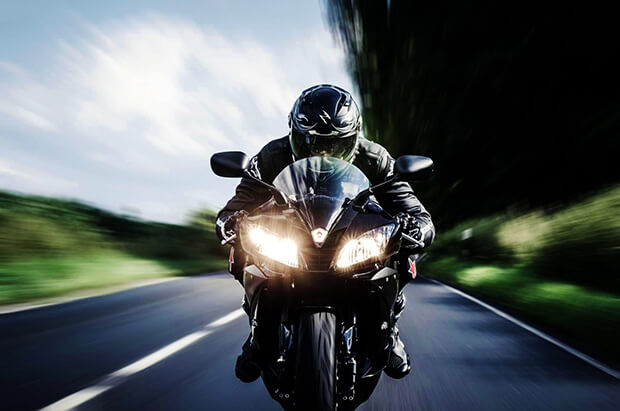
Fake Motorcycle Helmets
A motorcycle helmet is probably the most important purchase a motorcyclist will ever make.
That is why it is extremely important that when you buy a helmet, you are buying a real one.
You may have already heard about the dangers of buying fake motorcycle helmets online but for those that have not, we have outlined some information below on the importance of helmet safety.
Buying a fake helmet is not like buying a fake Rolex. These fakes can kill! For sure, you can get a great bargain online but should you bargain with your life by chancing on a fake helmet?
If you are a motorcyclist, your first and main concern is your personal safety. This is paramount and something that you never take lightly. You know for a fact, that a helmet will save your life in the event of a collision, being hit by a car or you come off your bike. God forbid, that this would ever happen, but if it did, you want to be protected.
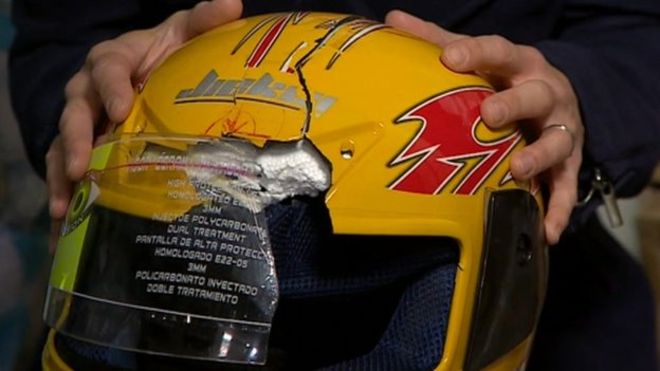
One of the main areas of concern for bikers is the online purchase of helmets. While the internet is always a good place to get a bargain, you really do need to take extreme care if buying a helmet online, specifically if it is not from a recognised supplier.
Fake motorcycle helmets can be extremely dangerous and even life-threatening. A big problem now is the accessibility of helmet purchase online and no real way of knowing that the helmet you purchase is, in fact, safe and has been manufactured to a very high standard by a bonafide helmet manufacturer.
A motorcycling publication in the UK recently published the results of 50kmh crash safety tests on helmets bought online. Their result found that some of the helmets purchased from online vendors did not conform to strict EU product safety standards and offered little protection. Some of these helmets actually split apart on impact.
Is a serious head injury, brain damage and even death a good tradeoff for a substandard cheap ripoff helmet? MyVehicle.ie is not here to endorse any helmet manufacturer or any brand but it is here to draw attention to potentially life-endangering substandard safety helmets.
It's a given that motorcyclists do not have the same level of protection as a car driver so considering safety is of the utmost importance and proper top to toe personal protection is a must.
Motorcycle Helmet Safety:
-
Never, ever buy a fake helmet
-
Never buy a second-hand helmet
-
Never buy a hairline cracked helmet
-
Never buy a helmet that is scratched
-
Never drop your helmet
-
Never paint your helmet
Proper fitting Helmet
Steps to choosing the right helmet size:
- Choose a helmet style.
- Determine your head shape and size.
- Try on the helmet.
- Check for proper fit.
- Wear the helmet for about half an hour.
- Still feels right? Go ride!
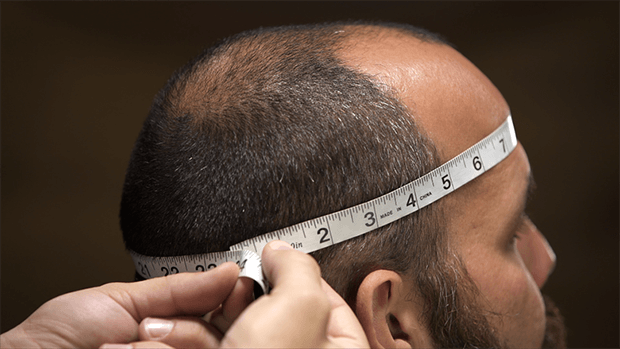
The fit of the helmet on your head is critical for your safety. It is suggested that you measure completely around your head just above your eyebrows to get the exact size. This measurement will give you an idea of what size helmet you need because they are definitely not one-size-fits-all. Helmet sizes go from extra small to extra large. Each manufacturer’s helmets will fit slightly differently so it's important to try on for bets size and comfort. For example, a small helmet in one brand could be close to a medium in another brand.
When trying on a helmet in the store or dealership, the chin strap should be tight enough that only two fingers will be able to fit between the strap and your chin. You should not be able to feel any gaps around your head. The helmet should fit snugly like a glove and not so tight that it’s uncomfortable.
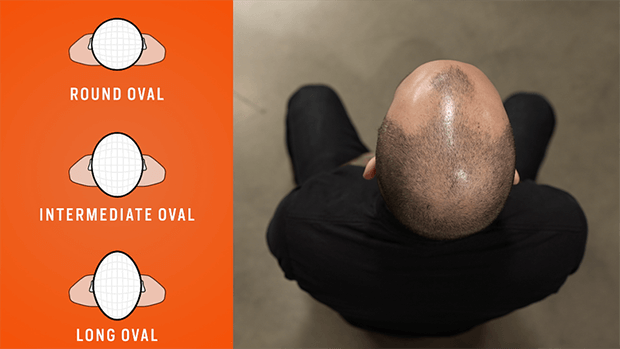
It is recommended to wear the helmet for a few minutes to get the feel of it moving it around with your hands to gauge the comfort and fit. Your cheeks should move when you move the helmet. The helmet should never rotate or move in any direction other than the direction of the movement of your head.
You can test the fit of the chin strap by looking down towards your chest while trying to push the back of the helmet upwards. If you are able to push the helmet up, it is probably not the best fit for you.
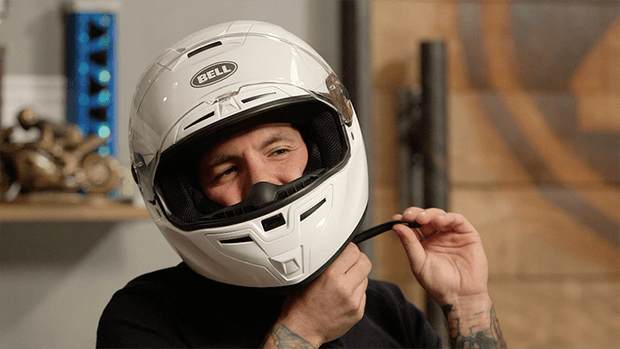
Fake or Counterfeit?
Fake, counterfeit or substandard products? Does it matter? To counterfeit means to copy something authentic like using the same logo by a usually well-known and highly sought after brand with the intent to steal, destroy, or replace the original. These items are created to deceive individuals into believing that the fake item is the real thing.
On the other hand, there are many products out there, such as cheap helmets that are poor, substandard products. Just because they do not claim to be from a genuine brand and are not counterfeit does not make them safe.
Both counterfeit fake items and poorly manufactured helmets can be unsafe and do not adhere to safety standards.
A motorcycle helmet could save your life so it's important to get the correct advice from an expert before fitting and purchase. Always buy your helmet from a reputable dealer as they can talk to you about your requirements and offer advice on the different types of helmet available and, more importantly, measure you for an exact fit.
Helmets are not a one-size-fits-all piece of safety equipment so buying a helmet online flies in the face of reason as you should always have a properly fitted helmet. When purchasing a motorcycle helmet, there are many different options that you can choose.
There are six main types of motorcycle helmets: full-face, modular flip-up, open-face, half-helmet, off-road, and dual-sport.
-
Full Face Helmet
-
Modular (Flip-up) Helmet
-
Open Face (¾) Helmet
-
Half Helmet
-
Off-road Helmet (Dirt Bike, Motocross, or MX)
-
Dual-Sport Helmet
Full-Face Helmets
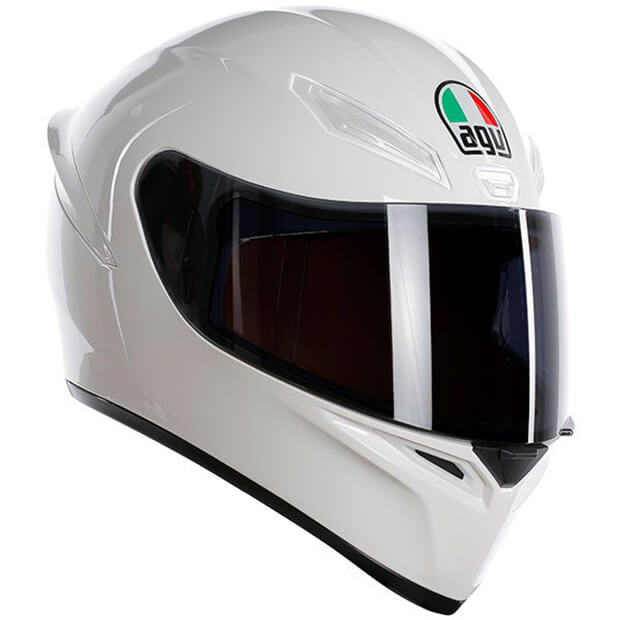
Full-Face helmets with a chin section are probably the most popular type of helmet as they can offer you frontal face protection in the event of a crash. These types of helmets give the greatest protection.
This type of helmet offers the most coverage around your head, face and neck and is considered the safest motorcycle helmet
One distinguishing feature of the full-face helmet is the chin bar, which is a key safety feature that many other safety helmets lack. According to a study on helmet damage and motorcycle head injuries, the chin encounters fifty per cent of severe impacts during and accident. Only a full-face helmet can provide protection for your chin and jaw.
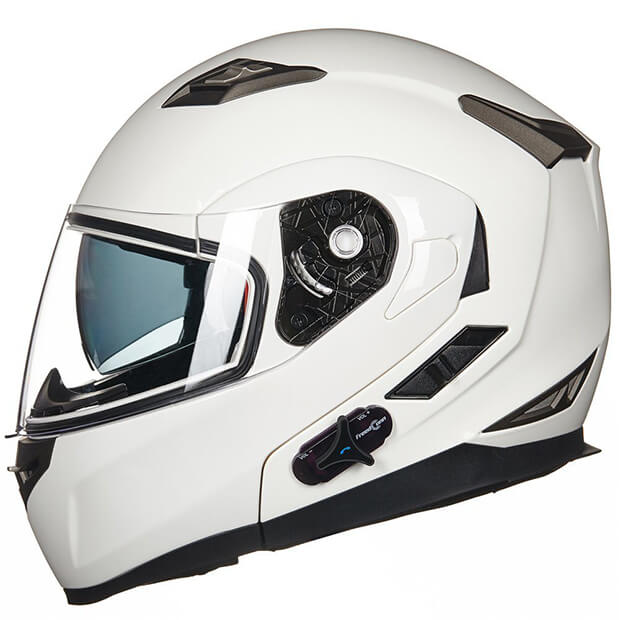
The full-face motorcycle safety helmet is a versatile choice for all bikers, regardless of the kind of motorcycle you have. The full-face helmet can vary depending on the type of riding you do. For example, Sports riders are in a crouched riding position and so they need a helmet that will not lift up and back at high speeds, so, they usually opt for a helmet with a higher chin bar and a visor opening angled slightly towards the top of the helmet.
On the other hand, tour bikers and general cruisers tend to ride with an upright riding position, so the helmet would have to accommodate it with a lower chin bar and a visor opening that is more direct and straightforward.
Full-face helmets also have ventilation in order for sweat to evaporate and to reduce visor fogging. The ventilation also helps and keep you cool while riding. In cold weather, the ventilation can be closed to reduce the airflow.
Full-face helmets have developed in recent years and now you can get additions such as Bluetooth capable speakers, high-visibility colour options and designs, and visors that adjust to certain lighting conditions and tint.
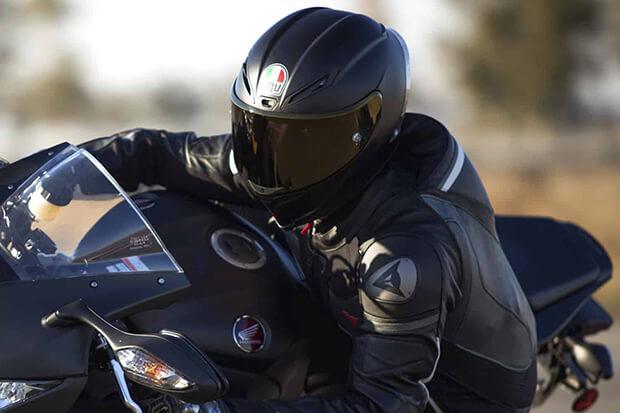
Modular (Flip-up) Helmet
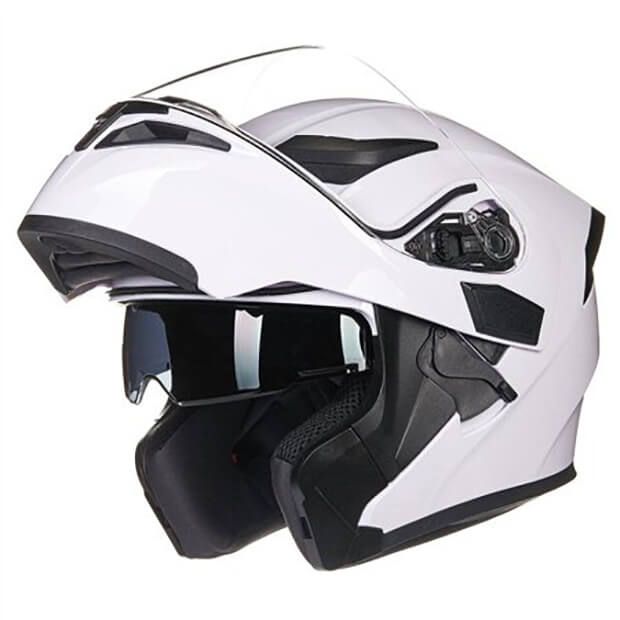 Modular helmets are also known as flip-up helmets. They are called flip-up because the chin bar and visor are connected and can be flipped-up to open the front of the helmet. These helmets are quite similar to full-face helmets. They also have a visor for eye protection as with the full-face but sometimes they have a secondary internal visor for sun protection.
Modular helmets are also known as flip-up helmets. They are called flip-up because the chin bar and visor are connected and can be flipped-up to open the front of the helmet. These helmets are quite similar to full-face helmets. They also have a visor for eye protection as with the full-face but sometimes they have a secondary internal visor for sun protection.
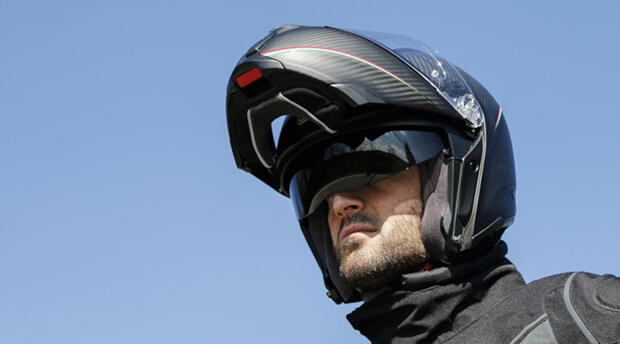
Flip-ups can sometimes be a little heavier than full-face helmets due to the extra design features. As well as this, rider safety is also slightly reduced because of the hinge structure. In saying that, these kinds of helmets stiff afford more protection than the ¾ or ½ helmets due to the added chin protection. The modular helmet is often used by tourers, cruisers and is designed with the upright riding position in mind.
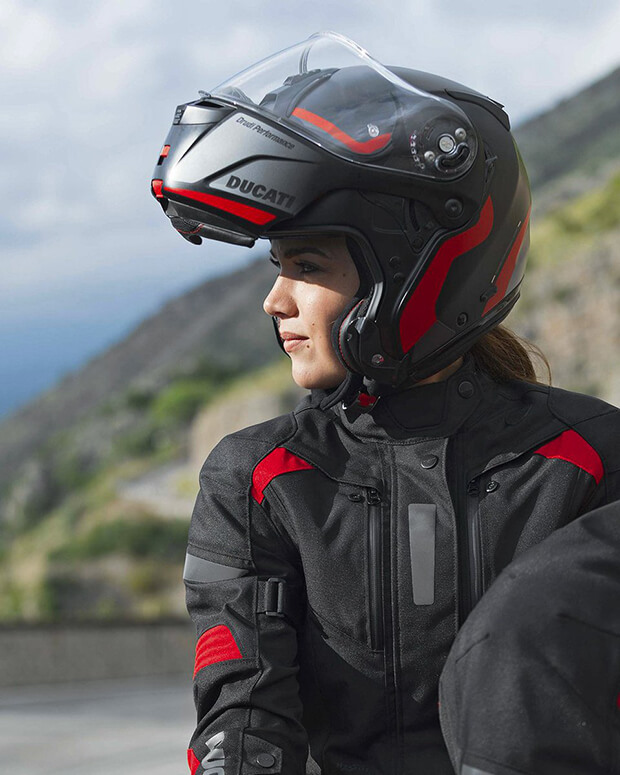
Open-Face Helmet
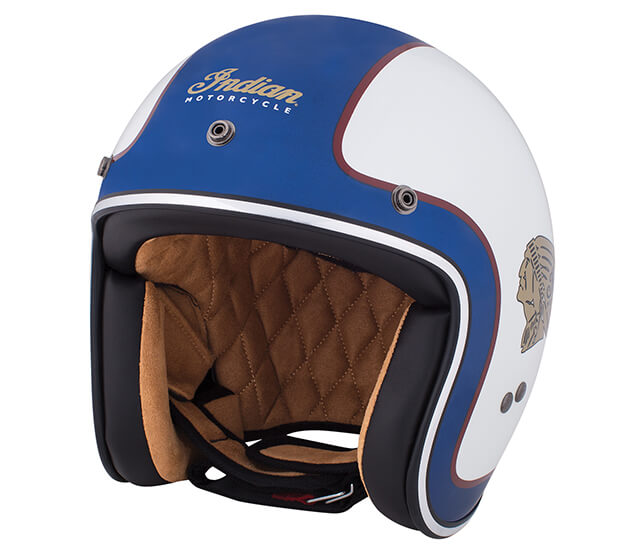
The Open-Face helmet is also known as a ¾ helmet and is kind of self-explanatory in that it covers the top, back and sides of your head but leaves three quarters or your face exposed. These types of helmets are popular amongst scooter riders, cafe racers (a lightweight, powerful motorcycle optimized for speed and handling rather than comfort – and for quick rides over short distances.) tourers, and cruisers, as the face area is kept open to the elements so the rider can feel the wind on their face.
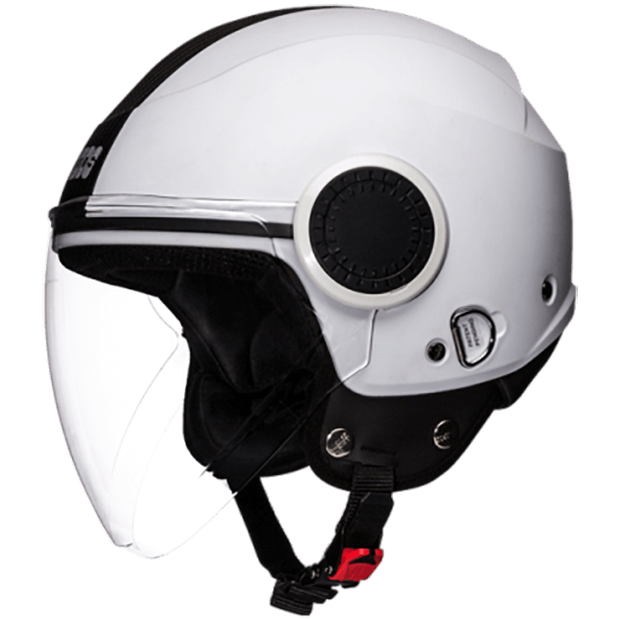
The open-face or ¾ helmet does not have a chin bar, and this can significantly reduce the safety of the motorcycle helmet because your face is fully exposed. Structurally speaking, this helmet is as equally safe as the full-face helmets in the areas that they cover apart from the face area.
This helmet is lighter, dues to the lack of facial structure and chin guard but not significantly lighter. It is also not great protection against the elements and your face will be exposed to weather and road debris. They can also come equipped with a partial visor or full-face visors to protect the face and from sunlight.
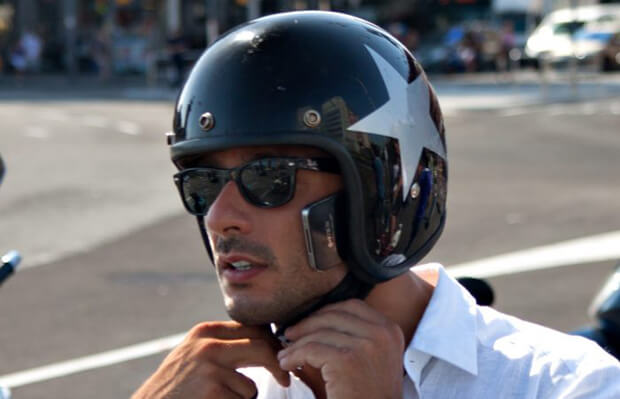
Half-Helmet
Half-helmets only cover the top of your head and only provide minimal protection. Some variations of this type may offer a bit more protection on the back of your neck and ears but the rest of your face left exposed. Half-helmets can obviously provide great airflow but there is a trade-off in safety as there is significantly less protection. In saying that, you can still get safety-approved half-helmets.
Most of the time, these types do not come equipped with a visor or face shield, so you have to provide your own eye protection in the form of riding glasses or goggles. These helmets are not designed to have additional features such as, Bluetooth speakers, for example, so they are quite limited in their safety features and add-on capabilities.
Off-road Helmet
The Off-road helmets are designed as their name suggests to be used on dirt roads and so they are not the best option for city and road use. It has a different design than the full and ¾ helmets as it is equipped with a larger visor and much more accentuated chin bar for better airflow.
The off-roader is designed for maximum protection, minimum weight, and flowing ventilation for riding during the warmer months. Off-road helmets usually do not have any eye protection, so the rider should use sunglasses or goggles which should be the preference as they can seal against the rider’s face to prevent debris intrusion from the bottom and sides while riding.
These helmets can come in a variety of materials including fibreglass, Kevlar, and carbon fibre. These materials give great strength and most importantly are lightweight so the sports rider can spend longer times in the saddle keeping their head and neck from becoming fatigued.
They are also designed to compliment body armour or a neck brace, but if you plan on wearing this other safety equipment, be sure to try the helmet on with the extra gear to be sure it all fits comfortably before you purchase the helmet. It is also important to test the goggles with the helmet so they seal to your face well. Some of these helmets may be shaped slightly differently around the eyes so not all goggle styles are a good fit. It may be necessary to purchase the goggles that the manufacturer has designed to match the helmet.
Dual-Sport Helmet
Dual-Sport helmets are a mix or half-way point between the off-road style helmet and a full-face helmet. They are designed to be used both on the road and off-road. The exterior of the helmet looks more off-road as it comes with a large visor and lower chin bar, but the inside of the helmet has more padding and comfort similar to a full-face helmet.
The dual-sport helmet affords you a larger eye protection visor than the full-face with offer a larger eye protection visor that a full face, but it can also snap into an up position for use of goggles. The visor is more aerodynamic and doesn’t lift in the wind like a true off-road helmet. The chin bar also does not protrude out as much as an off-road helmet, so there are better soundproofing and not as much airflow. This type is perfect for mixed-terrain riding when you find yourself riding on the road on your way to your off-roading destination. Hile on the main roads, you can have the visor in the down position and when you reach the trail you can snap it up for goggles and maximum airflow.
Motorcycle helmet build safety features
-
Outer Shell – The rigid, coloured outer shell usually consisting of Kevlar, carbon fibre, polycarbonate, moulded plastics, or a combination of those materials. Its primary function is to protect the head-on impact or abrasion and to prevent penetration from outside objects and debris.
-
Impact Absorbing Liner – on the inside of the helmet is typically made from EPS (expanded polystyrene) foam and this acts as a shock absorber shock displacing energy during impact. Some layers may be made from single density foam, while others may have a dual-density layer (two layers combined) for added energy displacement.
-
Padded Comfort Layer is the material that your head rests against while you’re wearing the helmet. This is usually made of an open-cell foam that is covered in a second cloth material. It is designed to absorb or drive away sweat and to keep you cool while riding. It can be removed for cleaning purposes, and can also be interchangeable to accommodate different head shapes.
-
Retention System – is also more commonly known as the Chin Strap – is secured below your chin to keep the helmet on your head while you ride. When properly secured, the chin strap should only allow for two fingers between the strap and your chin.
-
Vents – or ventilation system on the helmet acts to keep the rider’s head cool and to help evaporate off sweat as best as possible. Most vents have the option to open and close for different weather conditions.
-
Visor / Face Shield – is the safety feature that helps prevent bugs and debris, from hitting your face. The visor can also be removed for cleaning purposes or changed out when damaged or scratched. They can come in different colours and tints for sun protection and day/night conditions. A clear visor should always be used in low light and at night.
-
Cheek Pads – the full-face and ¾ helmets have cheek pads inside of the helmet for extra comfort and protection that are removable for cleaning and are customizable to accommodate different head shapes.
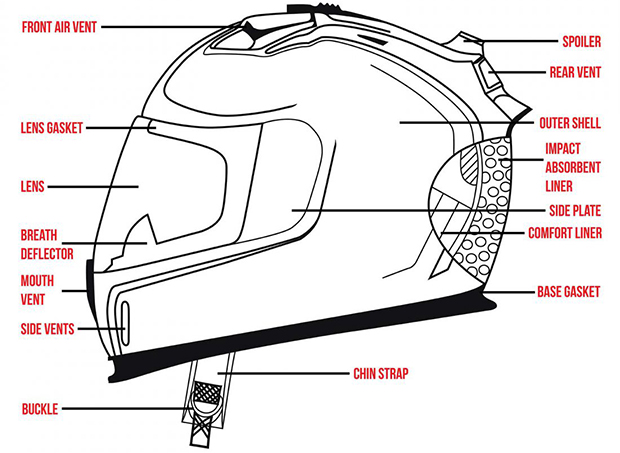
Expert Advice:
-
Consult an expert before purchase
-
Look for the E Mark
-
Buy from a reputable supplier
-
Should be the right size
-
Should fit comfortably and snugly
-
European product standard ECE 22.05
-
Be cautious about an online purchase
Look for the 'E' mark.

You should always be careful about buying a helmet online as you will not be able to try the helmet on for correct fit or may not be able to check if the helmet has been tested or certified to the necessary European product standard which is ECE 22.05 standard.
ECE stands for “Economic Commission for Europe,” which was created under a United Nations agreement in 1958. The 22.05 part refers to the specific regulation that the standards for testing are described in.
In the United States, there are two organizations that set safety standards for motorcycle helmets. The Federal Government's Department of Transportation (DOT) and the Snell Memorial Foundation.
DOT sets minimum standards that all helmets sold for motorcycling on public streets must meet. The standard is Federal Motor Vehicle Safety Standard 218 (FMVSS 218) and is commonly known as the DOT helmet standard.
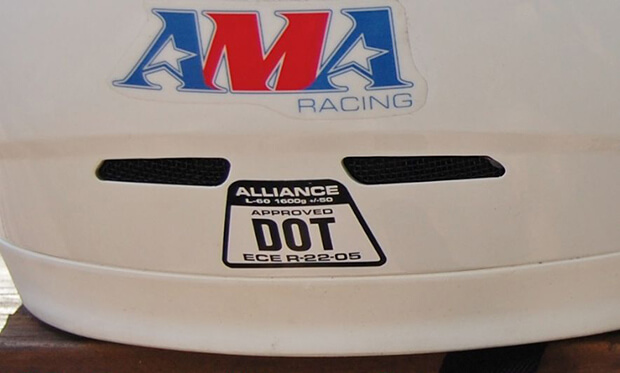
The Snell Memorial Foundation is a private not-for-profit organization that sets voluntary standards for motorcycle helmets, bicycle helmets and auto racing helmets, as well as other kinds of protective headgear. Snell claims that their standards are the world's toughest and also claim that they demand quite a bit more protective capability in helmets than anybody else on the planet.
Regardless of the type of helmet, make sure that the retention straps fitted to the shell have some type of restriction system to prevent the strap pulling through the buckle.
Do not dice with your life by being cheap. Get a real safety helmet that passes all the stringent tests. Don’t put your life in danger just to save a few quid. Do yourself a favour and purchase wisely and think safety.
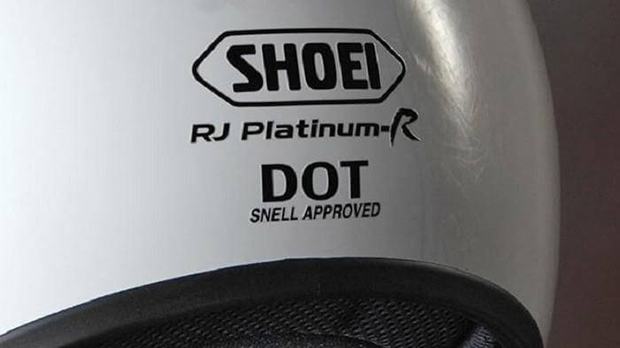
Author

Justin Kavanagh
Justin Kavanagh is a recognised leader
in automotive intelligence and vehicle
data supply to the entire motor industry.
He has almost 20 years experience in
building systems from the ground up.
As the Managing Director of Vehicle
Management System, he understands the
need and importance of trustworthy and
reliable vehicle history and advice to
both the trade and the public.
Follow me on LinkedIn